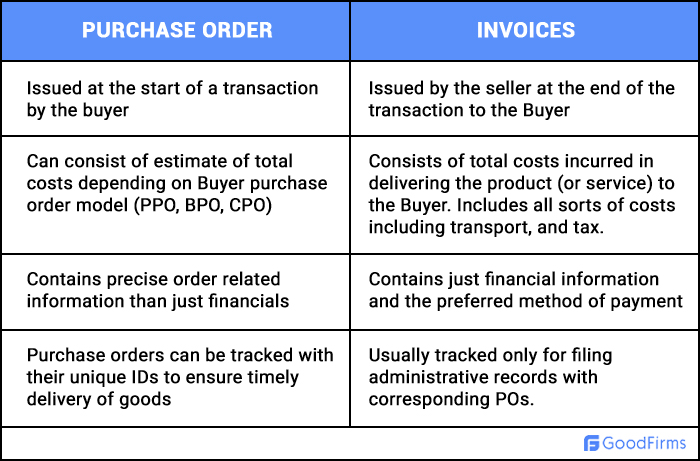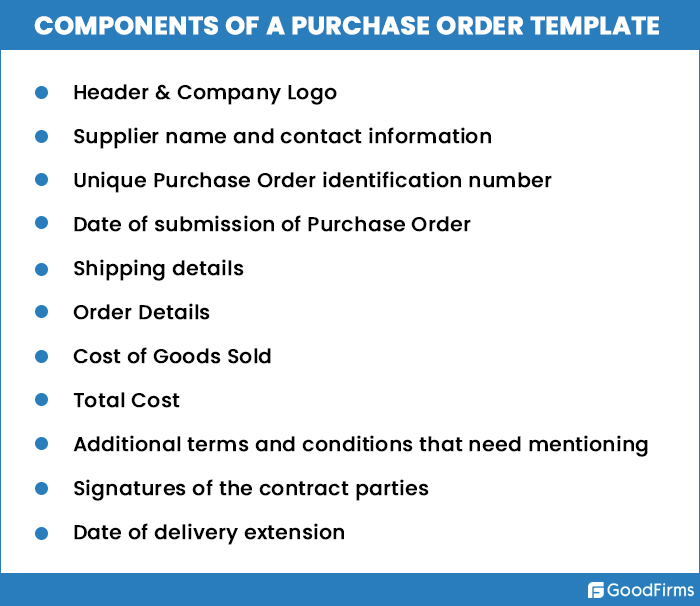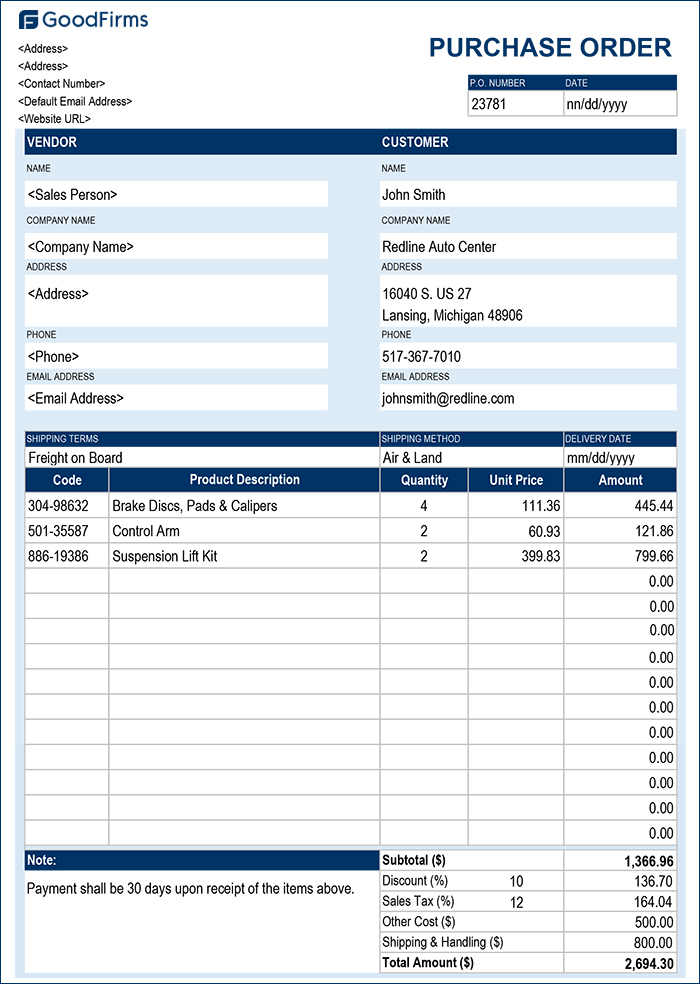Table of Content:
- What is a Purchase Order, And Who Uses It?
- Why Are Purchase Orders Critical For Businesses?
- Difference Between Purchase Order And Invoice
- What Are The Different Types Of Purchase Orders?
- What Are The Steps Involved In A Purchase Order Process?
- Why is it important to automate the Purchase Order process?
- Purchase Order Best Practices
- Benefits Of Purchase Orders
- Common Challenges Associated With Purchase Orders
- What Is A Purchase Order Template?
- What Are The Components Of A Purchase Order Template?
- Purchase Order Template Example
- Trends In Purchase Order Technology
What Is A Purchase Order, And Who Uses It?
Considered one of the most vital aspects of procurement, a purchase order (PO) is a document which the buyer of a product or service submits to a seller or supplier to initiate a purchase. A PO is a legally binding document which consists of information, or terms of purchase, from the buyer - such as the number of goods or services needed, total price, and order fulfillment time - which the seller has to fulfill. Once satisfied, the seller agrees to the terms of the purchase order, making it a contract.
Purchase orders fulfill two purposes -
1. They act as a record of all transactions between the buyer and seller
2. They protect the seller from any misdeeds of the buyer (such as sudden order cancellations, reneging, or previously agreed on terms, etc.).
Purchase orders spell out the finer details of all transactions between a buyer and seller, reinforcing trust and providing an audit trail for accounting purposes. The most effective purchase order is one that contains all the details necessary for the transaction to be successful.
Purchase orders find usage within every industry on the globe, particularly in inventory management. POs prove to be an excellent tool to formalize deliverables, keep track of progress, and account for different industries' costs. IT organizations use it to place orders for important organizational components both hardware and software. Manufacturing departments send POs to suppliers for multiple products (or services) that require niche expertise. Even government institutions issue POs for specialized equipment to multiple suppliers - ranging from defense to medicine. Most importantly, grocery wholesalers also issue POs when they need to acquire specific products for their customers from the market.
Therefore, one can easily understand the importance of purchase orders and their impact on business records. Furthermore, Simple business inventory software require purchase order control to successfully complete a purchase order request form, and submit to the necessary vendors quickly and efficiently.
Why Are Purchase Orders Critical For businesses?
Purchase orders signal a business’s intentions to proceed with the purchase of goods according to the terms of the agreement. One of the most important reasons for using it is legal stature - it binds the agreeing parties under law rules. This means that any contract variations are punishable by either total annulment or monetary settlement of the contract. This feature protects the interests and investments of the sellers and buyers.
Purchase orders also act as an audit trail for accounting purposes. They are accurate records of company spending on resources and limit spending wherever and wherever necessary. Tracking spending through POs also becomes extraordinarily critical and efficient. They are also crucial for budgeting and cash flow purposes. Financial control functions depend on the data contained within the POs.
Furthermore, POs also prove to be an apt tool to track a buyer's order progresser - from manufacturing to assembly and delivery. Internally, the PO tracking number assists companies in ensuring orders are delivered on time and ensure the honoring of all payment terms. Filing order invoices with the POs assist with accurate record keeping.
Purchase orders are the norm for any supplier, and assuring exceptional order fulfillment gets them the ‘best performer’ tag. Organizations tend to support the best performing suppliers,thereby fostering and solidifying relationships. Also, purchase orders help businesses organize, record, and track multiple transactions throughout a period, efficiently and with minimal time wastage.
Purchase orders also provide a clear, transparent, and formal communication method between the buyer and seller. It means that not only is this a recorded agreement, but there is clear and precise communication on what the expectations are - especially from the seller.
Difference Between Purchase Order And Invoice
Purchase order and Invoice may exchange hands between the buyer and seller, but both have entirely different purposes for which they find useful. It is important to remember that Warehouse inventory management software depends intrinsically on invoices for order clarification and verification post delivery. Online Inventory management systems then, store the invoices Here are some of the key differences:

Furthermore, purchase orders are unique to an organization's inventory management apparatus. They differ from work orders, which consist of labour and task division details. POs may be a part of work orders, requiring specific components from vendors to complete a task mentioned in the respective work order.
Despite the term contract used widely when a purchase order changes hands between a buyer and supplier, there is a fundamental difference - duration. Contracts are typically long-term agreements between a buyer and seller for multiple services or goods, while purchase orders are valid only for a single, short-term transaction.
Finally, purchase orders and sales orders too differ in one major way. While purchase orders are sent by the buyer to a seller, initiating the purchase process, sales orders are sent from the seller to the buyer, confirming the purchase and verifying the order components. It is generally sent after the seller receives and accepts the buyer’s purchase order.
What Are The Different Types Of Purchase Orders?
There are four types of Purchase Orders.
- Standard Purchase Order
This is the most basic type of purchase order and commonly used around the world. The buyer clearly states the essential details of the order - the product or service, quantity, payment terms, and order delivery schedule. The use of a standard purchase order dictates that the buyer has complete certainty on the necessary products. These purchase orders find use in one-time purchases or non-frequently demanded items.
- Planned Purchase Order (PPO)
PPOs are common for organizations looking to estimate future demand and planning in advance. These firms are sure of the goods or services they need, the quantity, and the payment terms, but not the delivery period. Hence, an agreement on delivering the goods according to a tentative plan. Upon finalizing a detailed plan, the firm issues a release against a PPO with an in-depth delivery schedule.
- Blanket Purchase Orders (BPO)
Like PPOs, BPOs engage buyers and sellers in a contract that includes the type of item but excludes the delivery schedule and the number of goods required. Sometimes, the price per quantity of goods purchased needs finalizing too, as this helps negotiating discounts for bulk deliveries. Typically, BPOs find use when different types of items need to be purchased, and all in good numbers. As with PPOs, the buyer needs to issue a release against the BPO and agree upon a detailed price, quantity, and delivery schedule for the seller to honor it.
- Contract Purchase Orders (CPO)
One of the most essential purchase orders, CPO,s usually do not list any specific details of the order fulfillment. CPOs act as a legally binding reference document, or basic terms of the agreement between buyers and sellers. Any future POs raised between particular parties bound by a CPO take its reference. These indicate a strong probability of long-term business relationships.

What Are The Steps Involved In A Purchase Order Process?
A purchase order process is complicated because of the number of stakeholders involved in a transaction. Also, purchase orders need to identify the resources a company is planning to buy, at what time, and at what cost. All of the above must be in line with what the seller can offer, before deciding on a merit of the PO.
The purchase order process is as follows:
- Purchase Requisition (PR) - Before creating a PO, the department - more specifically, the requisitioner (or requester) in the department - has to make a requisition document stating the exact purpose of acquiring goods, services from a vendor. Creating a PO depends entirely on the status of the PR document.
- Purchase Order (PO) Issuance - After PR approval, creating the POs becomes the next step. This stage decides prices, quantities, types, and delivery dates of goods or services bought. The PO issuance takes place after a financial authority approves of the terms within the organization.
- Seller Approval - Accepting or rejecting a PO then falls into the hands of a seller, who decides after viewing all the discussed purchase terms. Approvals (or rejections), cite the unique PO number sent out from the buyer.
- Order Fulfilment - Since the PO is a contract, the seller is duty-bound to serve the company or firm the products as stipulated in the PO. The buyer will file the PO and wait for delivery. Post-delivery, the organization will run over the items and compare them to the original PO items. The seller sends over an invoice highlighting the cost of goods and services, in the meantime.
- Approval and Payment - This is the final stage. Here, the buyer compares the PO with the invoice received and, on successful fulfillment, agrees to pay the seller a sum agreed at a predetermined rate.

Why Is It Important To Automate The Purchase Order Process?
Purchase order control is important because businesses can then analyze and pint-point excess cash outflow, and maintain exceptional relationships with suppliers. Many purchase order system processes need human intervention. The simple task of completing a purchase order form needs multiple rounds of vetting and discussions before issuance. The purchase order approval process brings the spectre of inefficiency to organizations, so much so that purchase order automation is now talked about as a must needed solution.
Purchase order automation would reduce the overall human involvement in purchase order request form filling, as well as the steps in a purchase order system. Purchase order approvals therefore could realistically be completed without much overhead, resulting in a quicker order placement and an agile inventory balancing system, with exact inputs from the purchase order forms itself.
Purchase Order Best Practices
Purchase Orders are not merely created at a whim. There is a great deal of thought, analysis, discussion, and approvals needed before issuing a PO to a supplier. Some of the best practices to be followed while creating POs are as follows -
- Create, optimize, and use the best supplier lists and databases
- Ensure appropriate budget estimations and restrictions during the creation of the PO
- Confirm and record PO modifications as necessary
- Involve all department staff in the PO requisition and creation process
- Script PO documentation as well as independent query sections
- Create the ideal PO cancellation process
- Ensure communication with sellers through authorized channels, especially while handing over the PO.
- Use digital, cloud ERP systems to prevent resource comprises
- Ideate and develop guidelines (procedure and principles) for the PO process
- Regulate PO process transparency
- Return policies for defect or undelivered packages
Benefits Of Purchase Orders
The power of inventory management systems may facilitate the easy creation, storage and issuance of purchase orders. However, POs themselves are mighty beneficial to small, medium, and large-scale companies owing to their capability of highlighting relevant information for any deal to progress forth. Here are some advantages of purchase order templates -

Common Challenges Associated With Purchase Orders
Purchase orders are a must if you deal with a supplier for essential goods or services to your business. However, there are various challenges associated with POs, which then debilitate small companies to move toward them.
First, purchase orders are tedious to create and maintain. Even if stored electronically, POs tend to be cumbersome to fill up, maintain, close, and issue to sellers and all concerned stakeholders. Plus, repeated POs need to be filled consistently - which tends to become an administrative overload in most organizations.
Second, small scale organizations do not find the constant use of POs appealing, especially with their order sizes and fulfillment needs. Many of these organizations place orders for as low as $300 and many times do not go above $1000. Using time and effort to create a purchase order for such a short amount is inefficient for them and sellers when orders can be instantaneous.
Third, the entire process of creating a purchase order is lengthy. Managers at senior positions need to approve of the terms of purchase, besides just planning for purchase. At the same time, sellers may reject a proposal and ask the company to rework specific aspects of the purchase order again.
Fourth, purchase orders, like most human tasks, are prone to errors. The errors include incorrect terms and conditions entry, wrong shipping dates and addresses, incorrect quantity mentioned, etc. The list is endless. These may affect supplier-buyer relationships and business finances if not vetted correctly before issuance.
What Is A Purchase Order Template?
A purchase order template is nothing but a strict order or pattern which many buyers use while framing the PO. The template contains fields for buyers to fill in all the critical information on the PO, so representing all necessary information is not taxation per se. A structured PO contributes to streamlining the purchasing process, removing ambiguity that resides in suppliers' mindsets.
Creation of templates occurs either through specialized tools such as Microsoft Word, and Excel, and specialized purchasing software such as Bellwether, Order MS, and Sage Intacct. A list of free and open source purchasing software is available for a buyer to refer to, while GoodFirms’ dedicated category page for the best purchasing software is accessible and contains multiple options as well. If you are planning to purchase a particular software to help your business, make sure to reference our exceptional buyer’s guide for buying software.
What Are The Components Of A Purchase Order Template?
A purchase order consists of a block of information necessary for the seller to supply buyers and fulfill their requirements. The components of a purchase order template usually include -

Purchase Order Template Example
Inventory software often allows bespoke creation of purchase orders. However, industry inventory management tool users also need to be aware that only a specific templa-te of the purchase order is generally accepted throughout the world. The PO must contain specific information, and Order Management Software must ideally allow creation and printing with all these fields. A purchase order template is below -

Trends In Purchase Order Technology
Purchase orders are going digital, especially through superb inventory tracking software. A great number of companies now run procurement software, usually hosted on the cloud, which makes PO entries, storage and retrieval extremely easy by the use of simple inventory management software.
Free Inventory Software also uses purchasing analytics to arrive at the exact figures for orders - down to the most significant detail. This helps buyers reduce excess inventory, finds patterns in orders to estimate the next PO issue date, and decides on which shipping method is best suited to an order keeping in mind other metrics on the inventory management software. Purchasing analytics is particularly useful for small and medium sized businesses, where small business inventory software helps keep inventory storage to a minimum.
Artificial intelligence is also supremely vital in the inventory management and purchasing process. In combination with analytics, buyers can determine supplier performance through real-time analytics of critical metrics and deliverables on the PO. Furthermore, machine learning helps businesses review and approve important information on the PO without human intervention. It falls into the purview of automation through online warehouse management systems. Standardized computer programs can fill data on the PO, such as buyer details, seller details, delivery dates for repeat orders, etc.
Mobile devices today outnumber desktop units and purchasing software certainly followed the adaptation trend of most Enterprise Resource Planning (ERP) tools. Individual personnel within the buying department may access the purchase order function and create one on the go. Inventory management software helps curtail the communication gap intra-department, while ensuring the right decisions are made all over the company.
Furthermore, all inventory management systems today equip themselves with tools necessary for the entire purchase order process with features such as order management, order fulfillment, and other purchasing functions that contribute towards generating a PO and processing the order quicker and more efficiently than ever.
Conclusion
The dependence on Inventory management and inventory management software continues to grow throughout industries. With the world focusing on a lean inventory and maximum savings, combined with analytics - purchasing orders will need regulation and clear-cut precision to ensure all organizational goals are met. Thankfully, inventory management software allows you to do just that. Purchase order templates are extremely important and sticking to the right template will eliminate any misgiving that may arise into the purchase process between buyer and seller.
If you want to try out some of the best purchasing, or inventory software for your business, GoodFirms has a plethora of options which will help your business maximize efficiency. The free and open source procurement software blog, the free and open source inventory management software, and order management systems - besides others - are resources which will help you determine the best choice for your organization at the lowest possible price, hassle-free. GoodFirms’ well crafted Buyers Guides - for procurement software, as well as inventory management software, will guide you in the right direction as far your decision making goes.
Have feedback about this article? Let us know in the comments section below, or drop us a note on the feedback page. If you feel that you need to delve, and read more about multiple software categories , then you can do so through our software directory.



